AMD FX-8370E CPU Review: Vishera Down to 95W, Price Cuts for FX
by Ian Cutress on September 2, 2014 8:00 AM ESTGaming Benchmarks
F1 2013
First up is F1 2013 by Codemasters. I am a big Formula 1 fan in my spare time, and nothing makes me happier than carving up the field in a Caterham, waving to the Red Bulls as I drive by (because I play on easy and take shortcuts). F1 2013 uses the EGO Engine, and like other Codemasters games ends up being very playable on old hardware quite easily. In order to beef up the benchmark a bit, we devised the following scenario for the benchmark mode: one lap of Spa-Francorchamps in the heavy wet, the benchmark follows Jenson Button in the McLaren who starts on the grid in 22nd place, with the field made up of 11 Williams cars, 5 Marussia and 5 Caterham in that order. This puts emphasis on the CPU to handle the AI in the wet, and allows for a good amount of overtaking during the automated benchmark. We test at 1920x1080 on Ultra graphical settings.
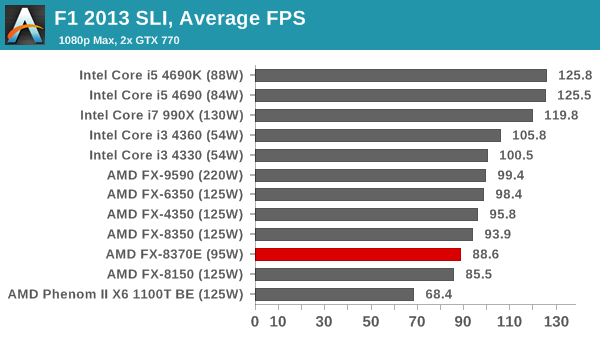
In all combinations, the 8370E and the 8150 duke it out. F1 2013 seems to be an Intel dominated title, given the i3 and outperform the FX-9590.
Bioshock Infinite
Bioshock Infinite was Zero Punctuation’s Game of the Year for 2013, uses the Unreal Engine 3, and is designed to scale with both cores and graphical prowess. We test the benchmark using the Adrenaline benchmark tool and the Xtreme (1920x1080, Maximum) performance setting, noting down the average frame rates and the minimum frame rates.
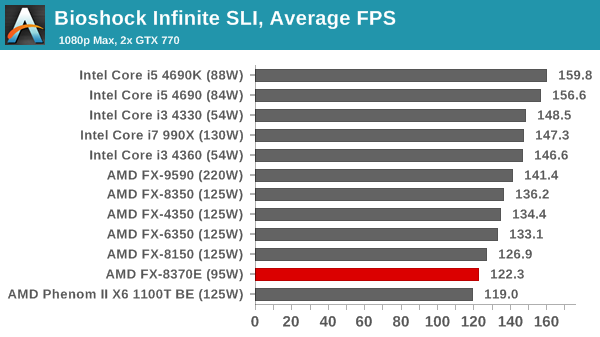
The FX-8350 again fits in just beneath the FX-8150, but for a lower power consumption.
Tomb Raider
The next benchmark in our test is Tomb Raider. Tomb Raider is an AMD optimized game, lauded for its use of TressFX creating dynamic hair to increase the immersion in game. Tomb Raider uses a modified version of the Crystal Engine, and enjoys raw horsepower. We test the benchmark using the Adrenaline benchmark tool and the Xtreme (1920x1080, Maximum) performance setting, noting down the average frame rates and the minimum frame rates.
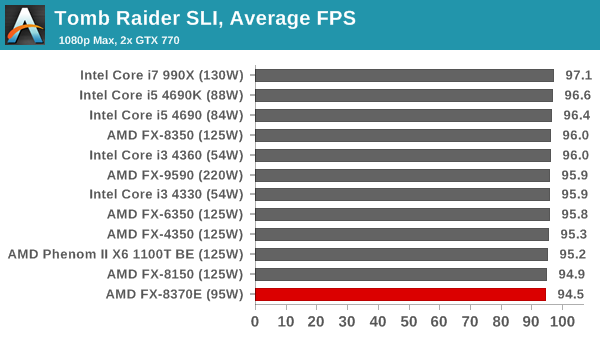
Tomb Raider continues to be CPU agnostic, even around the FX quad thread CPUs.
Sleeping Dogs
Sleeping Dogs is a benchmarking wet dream – a highly complex benchmark that can bring the toughest setup and high resolutions down into single figures. Having an extreme SSAO setting can do that, but at the right settings Sleeping Dogs is highly playable and enjoyable. We run the basic benchmark program laid out in the Adrenaline benchmark tool, and the Xtreme (1920x1080, Maximum) performance setting, noting down the average frame rates and the minimum frame rates.
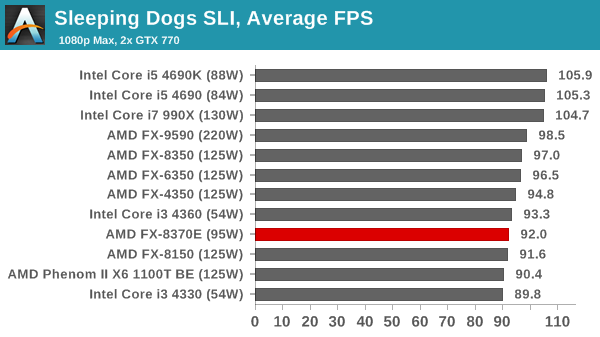
The eight threads offers some advantage in minimum frame rates, but average frame rates are still around the FX-8150.
Battlefield 4
The EA/DICE series that has taken countless hours of my life away is back for another iteration, using the Frostbite 3 engine. AMD is also piling its resources into BF4 with the new Mantle API for developers, designed to cut the time required for the CPU to dispatch commands to the graphical sub-system. For our test we use the in-game benchmarking tools and record the frame time for the first ~70 seconds of the Tashgar single player mission, which is an on-rails generation of and rendering of objects and textures. We test at 1920x1080 at Ultra settings.
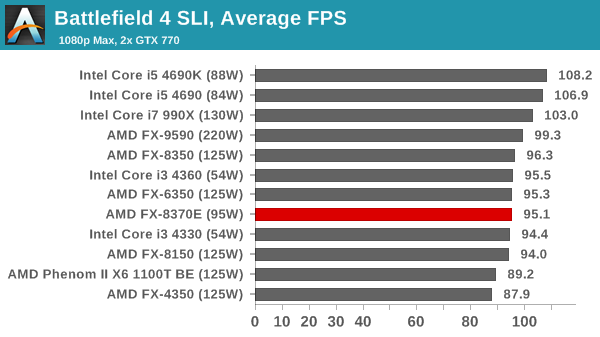
The FX-8370E stretches its legs a little in terms of minimum frame rates, particularly in SLI, however it is handily beaten by the i3-4330.















107 Comments
View All Comments
Atakelane - Wednesday, September 3, 2014 - link
A M ... what? I think this will be the reaction of the next gen of gamers to the once legendary AMD name. What has gotten into them ? I am an Intel and Nvidia fanboy but the problem is, the lack of competition from AMD (with their much hyped but pseudo multi core processors) to Intel has made sure Intel can trump them with just dual core fixed clock CPUs. I think Intel would have been forced to bring unlocked quad cores to the lowest end processors with proper competition.East17 - Wednesday, September 3, 2014 - link
One thing that has become obvious during the past 14 years or so is that EVERY TIME a new benchmark is introduced, AMD processors are ALWAYS competitive, just like the new x265 4K benchmark. Even the APUs are competitive.Then Intel updates its free compiler too and while its CPUs maintain their performance, the AMD chips are suddenly less capable in the new version of the program.
Intel is free to do whatever it want with its compiler and the software is actually good and useful, BUT the developers using Intel's compiler should respect AMD users and patch their software accordingly.
It is publicly known that if you use Intel's compiler on your software, it will identify the CPU and if it's an Intel one, it will run the most efficient routine, but if it's an AMD chip, it will run the "most compatible" routine that's considerably slower.
If the developer respects his customers and wants to offer a correctly and completely optimized piece of software, he should patch his product to run the most efficient routine on AMD CPUs too.
HisDivineOrder - Wednesday, September 3, 2014 - link
The reason AMD is making this part has less to do with data showing users who want to upgrade and more to do with users who are looking for new upgrades. They go and they can either buy CPU's that show as released over two years ago or they can buy new ones with new names that show newer releases dates. Even if the reviews state these CPU's are essentially the same as the older parts, there is a large group of users who won't care so long as the CPU's are "new."This is the same reason you saw the R9 280/280X, etc, get their flashy new name last year in spite of the cards being the exact same design as the older one.
Rebadges are more about perception than reality.
Ehetlaios - Thursday, September 4, 2014 - link
GUYS ENOUGH WITH SUPERBENCHMARKING AND SUPER INTEL TECHNOLOGY. THIS TIME WE DONT NEED THE EXTRA PERFORMANCE. INTEL DID THE SAME THING -PUMB THE SPEED AND VOUALA YOUR I7 4790K. THEY HAVE PROBLEMS WITH 14NM PROCESS. SO WHEN THE SANDY BECOMES THE REAL WALL POINT AND THE 22NM DIDNOT OFFER A PUMP OF 35% REAL PUMB ON PERFORMANCE IS LOGICAL TO SEE TINY AMD STAYS AT 32NM WITH LOW PRICES. AS FOR ENERGY EFFICIENCE ARE JUST BUBU 40$ OR 50$ LESS WITH INTEL IN 5 YEARS. ITS SAD THAT SANDY AND PILLDRIVER IS STILL HERE IN PERFORMANCE WAY. THE OLD DAYS OF 50% PUMB FROM GENERATION TO GENERATION ARE OVER. AS FOR INTEL WILL GIVE YOU 6 CORES WITH 12 THREADS I7 5790K BROADWELL AND I5 4 CORES WITH 8 THREADS I7 5820K SHOWED THAT< IF THE 14NM WILL SCALE GOOD ENOUGH IN EARLY 2015 OR SUMMER. SO AMD WITH 14NM OR 16NM WILL STRIKE WITH NEW DESIGNED 8C0RES WITH 16 THREADS IN 2015 Q4 OR 2016 Q1 IF THIS WILL BE FAILDOZER OR BRUTAL ATHLON WE WILL SEE THAT. SORRY FOR MY BAD ENGLISH.BiggieShady - Thursday, September 4, 2014 - link
How come we have AMD processors with lower TDP and no thermal tests?GrigioR - Thursday, September 4, 2014 - link
So... That's for people that are still using Phenon ll's /Athlon ll's (maybe even low end fx's) Those low TDP chips are for people that have 95w max power boards. Simple as that.Yes, they do quite fine but i would NOT recommend them to any new builders. They are 'viable' upgrade options for AMD users.
That said, USD 200.00 on that chip? No, and no. Buy an I5, period. If you have a AM3 board and you fit in that description (Phenonll/Athlonll)... go ahead, better performance with less power/heat.
darknite414 - Tuesday, September 16, 2014 - link
I wonder how many times I have to hear the FX series isn't as good as the i5 or i7. I think I get it, most didn't plan on buying just wanted to sound cool! News flash....you don't.